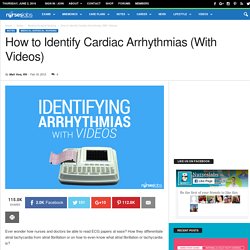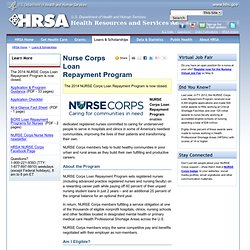

How to Identify Cardiac Arrhythmias (With Videos) And Nursing Responsibilities. Ever wonder how nurses and doctors be able to read ECG papers at ease?

How they differentiate atrial tachycardia from atrial fibrillation or on how to even know what atrial fibrillation or tachycardia is? ECG reading takes some serious skill, a keen eye and a good theoretical foundations on the different dysrhythmias and the concepts around heart’s conduction and about the ECG machine itself. It takes time to develop a skill in interpreting ECGs, but once you get the hang of it, you’ll be able to interpret any squiggly line in the ECG paper.
So What’s an ECG? ECG (or sometimes EKG) stands for electrocardiogram which was invented Willem Einthoven wherein during his experimentation, instead of using the usual adhesive leads as we have today, he would immerse each of the patients limb into containers of salt solutions and from there, their ECG was recorded. Sinus Tachycardia Sinus tachycardia is a heart rate greater than 100 beats per minute that originated from the sinus node. Confessions of a student nurse. Pharmacology tables « Nursing student pharm help. Free Resourses: Clinical pocket guides, Anatomy Flash Cards - Nursing for Nurses. Improving Your Odds! Plan Ahead For Diagnostic Studies: An increasingly important consideration in planning cannula size and placement is the likely diagnostic imaging strategy that the patient will need.

If computed tomography (CT scan) with intravenous contrast will be needed, e.g., spiral thoracic CT to rule out pulmonary embolism, etc., then it is usually necessary to have a 20 gauge or 18 gauge or larger short cannula peripheral IV in place using an upper extremity. This is so because the scan involves "power injection" of 75 milliliters of contrast at a rate of 10-20 milliliters/second with pressures up to 300 p.s.i. The scan travel is timed and calibrated to this injection rate as it seeks the pathology.
This may be in contradistinction to the perhaps lesser cannula requirements of the patient's clinical condition. Central lines, peripherally inserted central lines (PICC), and other vascular access devices (VAD), are usually excluded to avoid rupture of the catheter. IHI Open School. Why Are So Many Students Still Failing Online? - Do Your Job Better. By Rob Jenkins Online learning has become the third rail in American higher-education politics: Step on it and you're toast.

That's especially true at community colleges, where many leaders have embraced online courses with an almost religious fervor. And we all know why. It's not because anyone is seriously arguing that online classes are consistently better than the face-to-face versions. And it's not even necessarily because students are clamoring for them (although they're clearly popular in certain segments of the population, such as stay-at-home parents, people with full-time jobs, and deployed members of the armed forces).
In other words, at many community colleges, online classes constitute the proverbial cash cow. At least it sometimes seems that way. To all of you out there shaking your heads at my ignorance, can we perhaps find common ground? That debate should be reserved for faculty members and academic administrators. My suggestion was met with stony silence. Nursing Education Loan Repayment Program. The 2014 NURSE Corps Loan Repayment Program is now closed.

NURSE Corps Loan Repayment Program enables dedicated registered nurses committed to caring for underserved people to serve in hospitals and clinics in some of America's neediest communities, improving the lives of their patients and transforming their own. NURSE Corps members help to build healthy communities in poor urban and rural areas as they build their own fulfilling and productive careers. About the Program NURSE Corps Loan Repayment Program sets registered nurses (including advanced practice registered nurses and nursing faculty) on a rewarding career path while paying off 60 percent of their unpaid nursing student loans in just 2 years – and an additional 25 percent of the original balance for an optional third year.
NURSE Corps members enjoy the same competitive pay and benefits negotiated with their employer as non-members. Am I Eligible? Funding preference is based on your financial need and the facility where you work. Scholarships and other resources.pdf (application/pdf Object) Undergraduate Scholarship. The Foundationof the National Student Nurses’ Associationin Memory of Frances Tompkins www.nsna.org 2015 SCHOLARSHIP PROGRAM nsna@nsna.org The application will be available from August 2014 until January 2015 on www.nsna.org, click on Foundation & Scholarships U.S. citizens and students with an Alien Registration number currently enrolled in state-approved schools of nursing or pre-nursing in associate degree, baccalaureate, diploma, generic doctorate, and generic master's programs.

Funds are not available for graduate study unless it is for a first degree in nursing. Graduating high school seniors are NOT eligible. The NSNA Foundation awards over $345,000 annually in the general scholarship and promise of nursing programs. Promise of Nursing Scholarships are available in selected regions of the US. The scholarships are based on academic achievement, financial need, and involvement in nursing student organizations and community activities related to health care.
S Nursing Center: Nursing Practice, Cases, Courses, Databases, Lectures, Journals, Videos, etc. Nursing Study Resources.